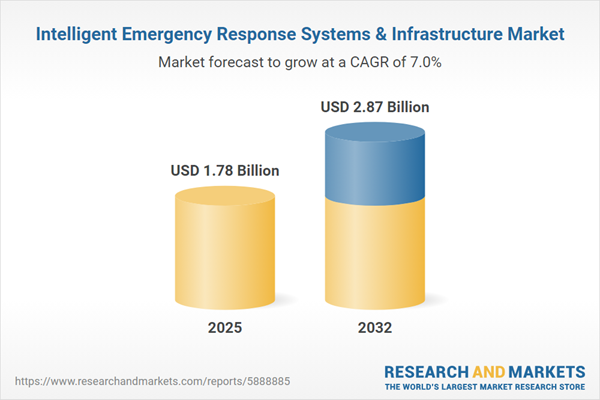Speak directly to the analyst to clarify any post sales queries you may have.
Senior decision-makers seeking robust solutions for risk management and regulatory compliance are increasingly focused on the intelligent emergency response systems market. This sector supports rapid, informed action and organizational resilience as threat landscapes and compliance expectations evolve.
Market Snapshot: Intelligent Emergency Response Systems & Infrastructure Market
The intelligent emergency response systems and infrastructure market is experiencing rapid expansion, attracting significant attention across both public and private sectors. Increased investment in digital platforms is fostering the growth of real-time communication tools, advanced incident management capabilities, and seamless interoperability for emergency preparedness. Organizations prioritize information sharing and reliability, resulting in closer public–private collaboration to upgrade and modernize their response systems. Leading solution providers are elevating operational dependability in high-pressure scenarios, responding proactively to both technological and regulatory changes. Recent advancements support enterprises as they adapt to heightened security demands and the ongoing complexities of risk and compliance environments.
Scope & Segmentation: Intelligent Emergency Response Systems Market
- Component: Advanced communication interfaces, scalable storage, analytics software, robust data servers, and environmental sensors together enable effective data management and swift, accurate responses during emergencies.
- Consulting & Integration Services: Deployment services such as asset tracking, monitoring, and GIS-enabled dispatch support organizational preparedness through every incident phase.
- System Type: Diverse platforms address various operational needs, including command and control, C3 solutions, decision support, LTE/radio networks, early warning systems, satellite modules, and drone-based components.
- IoT-Powered Sensors: Integrated sensors generate real-time situational intelligence, empowering leaders with actionable insights under time constraints.
- End User: Hospitals, clinics, military units, utility providers, event organizers, emergency medical teams, transportation authorities, and law enforcement agencies rely on these solutions for coordinated emergency management.
- Deployment: Flexible options include private, public, hybrid cloud, and on-premises infrastructure, allowing organizations to align with local regulations and operational needs.
- Application: Customizable approaches address scenarios such as chemical spills, industrial accidents, security threats, trauma care, disaster recovery, health emergencies, and severe weather events.
- Regional Coverage: Broad adoption spans North America, South America, Europe, the Middle East, Africa, and Asia-Pacific, with particular momentum in the United States, Germany, UAE, China, India, and Australia where regulatory environments encourage uptake.
- Company Coverage: Major market advances come from vendors like Motorola Solutions, Honeywell International, Siemens AG, Cisco Systems, IBM, Johnson Controls, Robert Bosch, Hexagon AB, Everbridge, and RapidSOS.
Key Takeaways for Senior Decision-Makers
- Integrated analytics strengthen organization-wide strategic decision-making and facilitate accelerated responses to evolving emergency scenarios.
- Adoption of 5G and satellite-powered frameworks ensures uninterrupted communication across remote and affected regions, supporting critical incident management.
- Open and modular architectures offer easier integration with existing systems, expediting modernization and reducing risks in system transitions.
- Artificial intelligence and machine learning increase the speed and accuracy of threat recognition, streamlining the deployment of resources where most needed.
- Collaboration between large solution providers and niche vendors fosters tailored solutions adaptable to unique operational and regulatory demands.
- Alignment with evolving local regulatory requirements enhances organizational agility and supports enterprise-wide digital transformation.
Tariff Impact on Emergency Response Supply Chains
Recent U.S. tariffs on electronic components have introduced additional cost pressures to intelligent emergency response systems supply chains. In response, organizations are adjusting procurement strategies, diversifying supplier bases, and optimizing logistics to maintain continuous access to essential technologies. These measures are designed to minimize the impact of market fluctuations and provide stability when engaging with critical mission-driven solutions.
Methodology & Data Sources
This analysis consolidates perspectives from emergency response professionals, technology experts, peer-reviewed research, industry-specific white papers, and regulatory frameworks. Regional patterns are examined to provide executive teams with focused, actionable conclusions and strategic guidance for effective decision-making.
Why This Report Matters for Senior Decision-Makers
- Delivers targeted, risk-aware intelligence for evaluating organizational investments and managing risk within alignment of business priorities.
- Enables leaders to develop strategic roadmaps for infrastructure improvements and operational changes, preparing for shifting compliance landscapes and threat profiles.
- Provides reference points for benchmarking technology adoption and regulatory preparedness, strengthening resilience and market competitiveness.
Conclusion
Intelligent emergency response systems equip enterprises to respond rapidly and effectively to new risks. Senior leaders can utilize this report to navigate compliance demands and build strong, informed emergency planning frameworks.
Additional Product Information:
- Purchase of this report includes 1 year online access with quarterly updates.
- This report can be updated on request. Please contact our Customer Experience team using the Ask a Question widget on our website.
Table of Contents
3. Executive Summary
4. Market Overview
7. Cumulative Impact of Artificial Intelligence 2025
Companies Mentioned
The companies profiled in this Intelligent Emergency Response Systems & Infrastructure market report include:- Motorola Solutions, Inc.
- Honeywell International Inc.
- Siemens AG
- Cisco Systems, Inc.
- International Business Machines Corporation
- Johnson Controls International plc
- Robert Bosch GmbH
- Hexagon AB
- Everbridge, Inc.
- RapidSOS, Inc.
Table Information
| Report Attribute | Details |
|---|---|
| No. of Pages | 189 |
| Published | October 2025 |
| Forecast Period | 2025 - 2032 |
| Estimated Market Value ( USD | $ 1.78 Billion |
| Forecasted Market Value ( USD | $ 2.87 Billion |
| Compound Annual Growth Rate | 6.9% |
| Regions Covered | Global |
| No. of Companies Mentioned | 10 |









